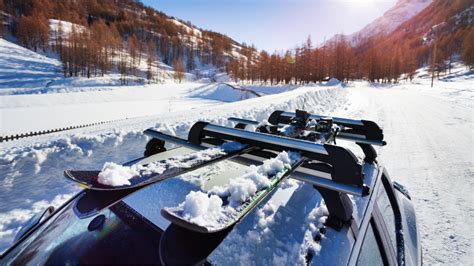Never Lose a Ski Again: Advanced Roof Rack Techniques
Losing a ski on the highway is a skier's worst nightmare. The frantic search, the potential for damage, the sheer inconvenience – it's a scenario best avoided. This article dives beyond the basics, offering advanced techniques to ensure your skis (and your sanity) remain safely secured to your roof rack. We’ll explore proper ski rack selection, securing methods, and crucial pre-trip checks to prevent those disastrous moments.
Why Standard Techniques Aren't Enough
While basic ski rack straps might seem sufficient, they often fall short in challenging conditions. High winds, sudden braking, and even uneven road surfaces can compromise their hold. Advanced techniques prioritize redundancy and a deeper understanding of force distribution, guaranteeing your skis stay put.
Choosing the Right Roof Rack System
The foundation of secure ski transport is a robust and appropriate roof rack system. Consider these factors:
- Rack Type: Crossbars are essential. Consider aerodynamic crossbars to minimize wind resistance and fuel consumption, especially on longer drives.
- Weight Capacity: Ensure your rack and crossbars can handle the weight of your skis, boots, and any other gear. Always check the manufacturer's specifications.
- Compatibility: Verify compatibility with your vehicle's roof rails or mounting points. Improper installation is a major cause of rack failure.
- Lockable System: Invest in a lockable system to deter theft. This adds an extra layer of security, peace of mind, and protection against opportunistic thieves.
H2: What's the Best Way to Secure Skis to a Roof Rack?
The key is multiple points of contact and redundancy. Avoid relying solely on one strap type. Here's a comprehensive approach:
- Proper Placement: Position skis parallel to the vehicle's direction of travel, ensuring even weight distribution.
- Individual Ski Straps: Use individual straps for each ski, securing them firmly to the crossbars. Don't rely solely on the ski rack's clamping mechanism; use individual straps to prevent shifting. Consider cam straps for their strong grip and easy adjustment.
- Compression Straps: These straps run across the entire ski load, compressing them tightly against the crossbars. This prevents movement and significantly reduces the risk of slippage. Use high-quality, heavy-duty straps.
- Additional Tie-Downs: For extra security, consider adding additional tie-downs at the front and back of the ski load, anchoring them to the vehicle's robust points. This further enhances security against high winds or sudden stops.
- Proper Strap Tension: Straps should be snug but not overly tight to prevent damaging the skis or the rack. Ensure straps are properly fastened and evenly distributed.
H2: How Do I Prevent My Skis From Getting Damaged on My Roof Rack?
Protecting your investment is crucial. Employ these damage-prevention strategies:
- Protective Padding: Use ski socks or protective sleeves to cushion skis and prevent scratches.
- Even Distribution: Avoid overloading the rack. Distribute weight evenly to prevent bending or damage to the skis or the rack itself.
- Secure Boot Storage: Store boots separately to avoid unnecessary weight and potential damage.
H2: What Should I Check Before I Start Driving?
A quick pre-trip inspection is essential.
- Visual Inspection: Check all straps for tightness and proper fastening. Ensure no part of the ski load overhangs beyond the vehicle's width.
- Test for Stability: Gently try to move the skis to verify the straps' holding power.
- Wind Conditions: Be aware of weather conditions. High winds can significantly impact the stability of your ski load. Avoid driving at high speeds in windy conditions.
H2: What if My Skis Are Too Long for My Roof Rack?
Oversized skis present a unique challenge. Consider these solutions:
- Extendable Crossbars: If your rack allows it, extend the crossbars to accommodate longer skis.
- Multiple Rack Systems: In some cases, using multiple roof rack systems might be necessary to accommodate extra-long skis.
- Rear-Mounted System: Evaluate the feasibility of using a rear-mounted carrier designed for skis or snowboards, depending on your vehicle's capabilities.
Conclusion
Transporting skis safely requires more than just throwing them on a rack. By employing advanced techniques and diligently checking your equipment before hitting the road, you can significantly reduce the risk of losing a ski, minimize damage, and maximize the enjoyment of your skiing trip. Remember, proper planning and attention to detail are your best allies in ensuring a smooth and worry-free journey to the slopes.

